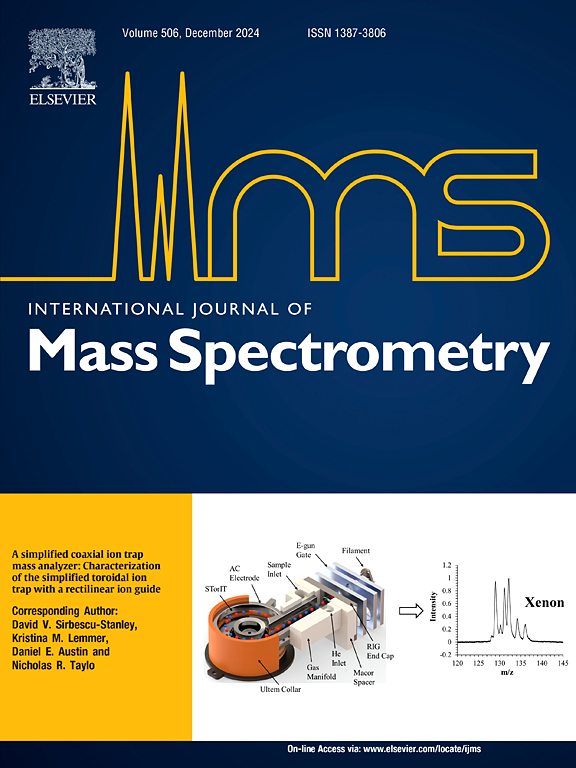Approaches with different reaction gases for the determination of iron in rare earth samples based on on-mass mode by inductively coupled plasma tandem mass spectrometer
IF 1.7
3区 化学
Q3 PHYSICS, ATOMIC, MOLECULAR & CHEMICAL
引用次数: 0
Abstract
The determination of iron using ICP-MS-MS is complicated due to the polyatomic spectral interferences, notably the 40Ar16O+ on the abundant 56Fe isotope. In this research, the utilization of three gases—helium, hydrogen, and methane—to accurately quantify iron was proposed using the on-mass mode by inductively coupled plasma tandem mass spectrometer. The conditions of the collision/reaction cell were optimized, particularly the gas flow rate and the hexapole bias voltage, for iron analysis. Different mechanisms, including collision and reactions like charge transfer reactions, hydrogen atom transfer reactions, and proton transfer reactions, were explored. In terms of sensitivity and background equivalent concentration (BEC), the hydrogen mode exhibited the highest sensitivity and the lowest BEC. The methane mode yields a comparable BEC to that of the hydrogen mode with a threefold reduction in sensitivity. The limit of quantification (LOQ) under the hydrogen reaction mode was as low as 0.028 μg/g.The analysis results of the national standard substance GBW07159 were in excellent agreement with the certified values, and the relative standard deviation (RSD) for n = 11 was less than 5 % in the three modes. The measured values and spiked recoveries for rare earth oxides were essentially consistent between the hydrogen and methane modes. Following validation, the hydrogen and methane reaction modes have been shown to accurately analyze iron in rare earth and rare earth oxides with high accuracy and stability, surpassing the helium mode in terms of collision mechanism.

电感耦合等离子体串联质谱计在非质量模式下测定稀土样品中铁的方法
ICP-MS-MS对铁的测定由于多原子光谱干扰,特别是对丰富的56Fe同位素的40Ar16O+的干扰,使测定变得复杂。本研究提出利用氦、氢、甲烷三种气体,利用电感耦合等离子体串联质谱仪的on-mass模式对铁元素进行精确定量。对碰撞/反应池的条件进行了优化,特别是气体流速和六极偏压。不同的机制,包括碰撞和反应,如电荷转移反应,氢原子转移反应,质子转移反应,进行了探索。在灵敏度和背景等效浓度(BEC)方面,氢模式灵敏度最高,BEC最低。甲烷模式产生了与氢模式相当的BEC,灵敏度降低了三倍。氢反应模式下的定量限低至0.028 μg/g。国家标准物质GBW07159的分析结果与认证值吻合良好,在n = 11的情况下,三种模式的相对标准偏差(RSD)均小于5%。稀土氧化物的测量值和加标回收率在氢模式和甲烷模式之间基本一致。经过验证,氢气和甲烷反应模式能够准确分析稀土和稀土氧化物中的铁,具有较高的准确性和稳定性,在碰撞机理上优于氦反应模式。
本文章由计算机程序翻译,如有差异,请以英文原文为准。
求助全文
约1分钟内获得全文
求助全文
来源期刊
CiteScore
3.60
自引率
5.60%
发文量
145
审稿时长
71 days
期刊介绍:
The journal invites papers that advance the field of mass spectrometry by exploring fundamental aspects of ion processes using both the experimental and theoretical approaches, developing new instrumentation and experimental strategies for chemical analysis using mass spectrometry, developing new computational strategies for data interpretation and integration, reporting new applications of mass spectrometry and hyphenated techniques in biology, chemistry, geology, and physics.
Papers, in which standard mass spectrometry techniques are used for analysis will not be considered.
IJMS publishes full-length articles, short communications, reviews, and feature articles including young scientist features.

 求助内容:
求助内容: 应助结果提醒方式:
应助结果提醒方式:


